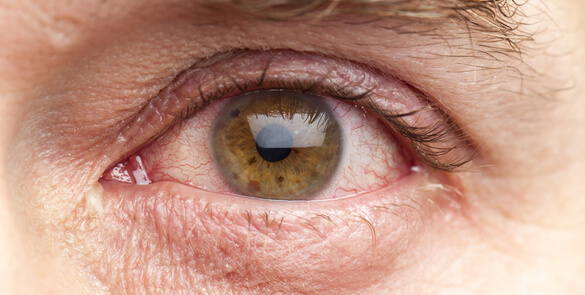Meibomian Gland Disfunction (MGD)
What is Meibomian Gland Disfunction (MGD)?
Meibomian glands in the eyelids comprise about 25-40 glands in the upper eyelid and 20 – 30 in the lower eyelid. The function of these glands is to secrete oils onto the surface of the eye. These oils stabilize the tear film to keep the surface of the eye moist and comfortable, helping to keep the tears from evaporating too quickly.
Meibomian Gland Disfunction is generally caused by a blockage or some other abnormality of the glands in which they don’t secrete enough oil into the tears, which then evaporate too quickly.
It is a leading cause of dry eye syndrome, resulting in evaporative dry eye associated with eyelid problems such as blepharitis or rosacea, which are chronic conditions that can be controlled well but not immediately cured.
MGD Risk Factors
Despite the fact that the cause of MGD is not known, we do know that there are some risk factors.
People over the age of 40 have a significantly greater risk of developing it than children or young adults.
Wearing eye makeup is another contributing cause, because eyeliner and other makeup can block the openings of meibomian glands, especially if you don’t thoroughly clean your eyelids and remove all traces of eye makeup before you sleep.
Some researchers believe wearing contact lenses may increase the risk of MGD. Eye surgeries can also be associated with MGD as patients tend to avoid cleaning the area around the eyes for several days after. However, researchers believe additional studies are needed to confirm the direct causative association in these groups.
How can I treat MGD?
The typical recommended treatment is applying local hot compresses to the eyelids, followed by massaging and wiping the surface. The goal of this treatment is to melt and express any thickened oil blocking the openings of the meibomian glands, however in some cases this won’t effectively relieve the symptoms.
What is IPL?
IPL stands for Intense Pulsed Light, it is an alternative way to treat MGD for the cases refractory to the conventional treatment. This is not a laser procedure. There is a filter to select the range of wavelengths that best warms the skin and closes the abnormal blood vessels associated with blepharitis and rosacea reducing the local inflammation and also stimulating normal secretion from the meibomium glands.
IPL is FDA (Food & Drug Administration, USA) approved for the treatment of rosacea, and has been used for many years to treat hair removal and sun spots.
How is the procedure performed?
The procedure begins with your eyes being patched for protection, and then a cooling gel is applied to the treatment area to absorb some of the heat from the light. A hand-held device is used to administer pulses of light to the cheek and surrounding area. There are multiple light pulses that are needed to be completed across those areas.
IPL is not a painful procedure. As the pulse of light is administered, there is a tingling sensation however no pain has been evidenced by patients for this procedure, based on our experience.
The cooling gel and eye patches are then removed, and after applying a drop to numb the eyes, meibomian gland expression is performed to release all of the thickened oil accumulated in the glands.
What should you expect after IPL treatment?
Patients will typically experience mild mucous discharge and irritation for up to 36 hours after the procedure and generally improve over a few days after their treatment.
Three treatments are usually needed, however the treatment may be less than this or more, depending on your doctor’s opinion and your individual outcomes.
After the treatment you can return to normal every day activities. When outdoors, the use of sunblock is recommended on the treated areas, as well as ensuring to wear sunglasses. average symptoms improve by 82% according to the medical literature.
However, this high rate can only be achieved with the supportive medication treatment prescribed by your doctor and other supporting therapy that the doctor might consider useful in your case.
What are the risks associated with IPL treatment?
IPL has been used safely for many years but there are always risks associated with any procedure. These include, but are not limited to, hyperpigmentation, hypopigmentation, infection, pain, scarring, burns, corneal abrasion, eye irritation, allergic reaction to the topical agents used, and ineffectiveness of the treatment. Whenever a procedure is done near the eye, some loss of vision must be considered a possible risk. However, in cases where eye shields have been used, no eye injuries or loss of vision have ever been reported.
